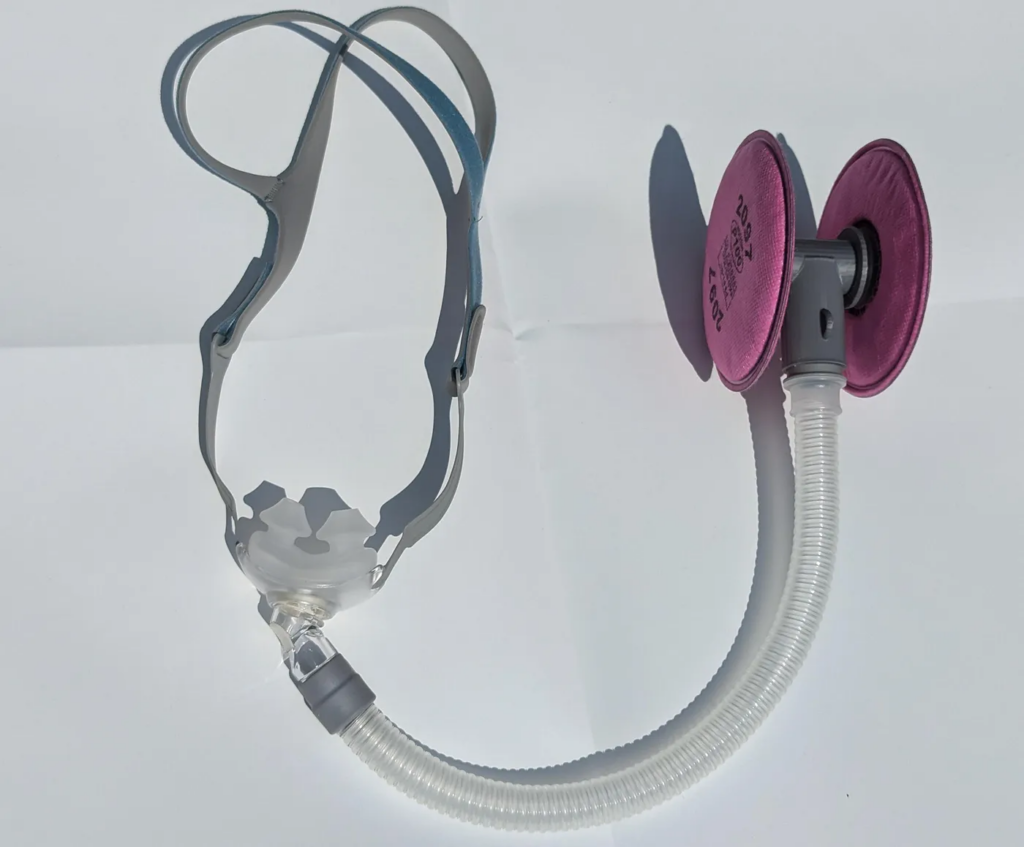Mitigation Measures
I have had good results with the Readimask, as mentioned before, but I have also occasionally had trouble with a gap forming under my chin. This post describes another method of sticking it on the face, which testing showed was far far superior. I tried it (though I haven’t done a DIY fit test yet because I can’t find my saccharine, *sob*!) and it feels like it is more secure. It is also IMHO better-looking.
This article reports that Nassau County (just east of NYC on Long Island NY) has banned masks passed a law banning masks, ostensibly to keep criminals from hiding their faces. There is an exemption that allows people to mask for health reasons, but the people who will decide what is a legitimate health reason will be a group not famous for being up on current health research and famous for enforcing laws unequally: the police.
This blog post shows how to make a device which gives you most of the benefits of a mask without hiding your face (and thus probably gets around mask bans). A hose connected to filters goes into your nose. It means that other people are not protected from you, and you have to learn how to breathe in through the nose and out through your mouth, but they can’t say you are hiding your face.

This paper from Italy (2024-08-05) reports that there was a spike in acute pediatric mental health crises when schools reopened, but not when they closed. There was a significant rise in psychiatric pediatric ER visits over time between 2018 and 2021; the authors suggest that part of that was just that everybody was stressed by, y’know, a deadly global pandemic, and part was that kids had a hard time re-adjusting to the stressors of school after being essentially out of practice for a while.
Long COVID
This paper from USA (2024-07-06) reports that COVID makes arterial elasticity was worse in people, especially women. They enrolled a lot of people, about 2/3 of which had Long COVID. The COVID-positive people had much lower arterial elasticity than in people who had never gotten COVID-19, people with Long COVID had even worse arterial elasticity, and women with long COVID had even even worse lower arterial elasticity.

This paper from Malaysia (2024-08-05) reports that taking Paxlovid didn’t change how well people were able to function — take care of themselves, work, etc. However, they did find that at six months, there was a 26% lower chance of symptoms associated with negative emotions such as sadness, anxiety and depression in people who took Paxlovid compared to the control group. This reduced risk of negative emotions was down from a 35% lower chance at three months.
The study authors rather brushed off that the risk of “symptoms causing negative emotions” was significantly higher in the control group, which I thought was inappropriate. While there wasn’t detail on why people were sad, anxious, or depressed, I can imagine that perhaps they were in pain. Pain might not interfere with your ability to do your job, dress yourself, work, and live alone, but it certainly can make your life worse!
The study did find that at three months, there was a 42% lower chance of symptoms limiting walking among people who took Paxlovid than those who did not.
This preprint from Germany (2024-08-01) reported that filtering specific antibodies out of Long COVID patients’ blood made 70% of the patients better (temporarily). The filtering reduced total IgG by 79.15 % and β2 AR-AB by 78.14 %, and their score on a common wellness survey more than doubled. Women’s grip strength also improved:

Alas, the authors noted that most patients started to get worse again after six months.
These findings seem consistent to me with there being a problem with blood platelets, causing overly-strong IgGs to get produced (as mentioned in my 2024-03-22 post’s Pathology section).
COVID-Related Excess Deaths and Sickness
This paper from England (2024-08-09) reports that Type 2 Diabetes risk was higher in people who got COVID-19 infections, even higher in infected people who were unvaccinated, and the risk dropped over time but didn’t go away.
Here were the increased risks at early and late time points for different cohorts compared to the rate before a COVID-19 infection (including pre-pandemic data):
| Cohort | Weeks 1-4 | Weeks 53-102 |
| Before vax available | 4.3x | 1.24x |
| Unvaccinated (Delta->Omicron period) | 8.76x | N/A |
| Vaccinated | 1.66x | N/A |
| Hospitalized | 28.3x | 2.04x |
| Unhospitalized | 1.95x | 1.11x |
Pathology
This paper from USA (2024-08-07) reports that children with Multisystem Inflammatory Syndrome-Children (MIS-C) have an antibody against a protein called SNX8 (which looks very much like a piece on the nucleocapsid (envelope) of the SARS-CoV-2 virion), which is an important part of a normal cell’s inner workings. So basically in MIS-C, kids’ bodies try to kill themselves. 🙁
This happens in adults too — it’s called MIS-A in adults — but it is much rarer. I don’t know why it is rarer in adults, and I don’t think anybody does.
This paper (2024-08-05) reports that genetic susceptibility to COVID-19 is unrelated to genetic susceptibility to influenza. Based on data mining (with permission!) DNA/geneology records, they found that published genetic risk factors for COVID-19 didn’t affect influenza risk. (They did find, for the first time, two genetic variants that raised the risk for influenza, which led them to a possible treatment, but that’s influenza and not COVID-19.)
Variants
I have been hearing some chatter — although not from what I consider top-tier news sources — about a new variant in China, XDV.1, which some sources say is a Delta/Omicron hybrid; other sources say it’s a multiple recombinant involving JN.1* and XBB.1* lineages. This article says that COVID-19 rates are currently going up in China, especially in Hubei.
Regardless, it is definitely different from the “deltacron” XD.1 which was spotted in March 2022. That one did not really take off.
Transmission
This paper from North Carolina (2024-08-05) reports that meatpackers/slaughterhouse workers were seropositive for COVID-19 at rates 1.5 to 4.3 times higher than the general population. They also found that people who worked in big companies (more than 1000 people) were 4.5 times more likely to have evidence of COVID-19 infection than those who worked for small (<11 people) companies.
Vaccines
This paper (2024-08-07) reports that vaccines saved an estimated 1.6M lives in 34 of the 54 countries in the WHO European Region. 96% of those were over 60 years old. This was a conservative estimate: they did not account for either herd immunity effects or the undercounting of COVID-19 deaths that they are pretty sure happened.
H5N1
Transmission
This article from Australia (2024-08-03) surprised me by revealing that H5N1 — which I thought had made it literally everywhere — has not arrived in Australia (yet). They do have bird flu there, but it’s an H7 strain, not an H1 strain.
This article from USA (2024-08-08) reports that there are now 190 H5N1 outbreaks in dairy herds from 13 states. 63 of those herds are from Colorado, which has has recently required samples of milk from farms’ bulk milk tanks — which revealed eleven herds this week. (Go Colorado for looking harder!)

1 comment
Comments are closed.